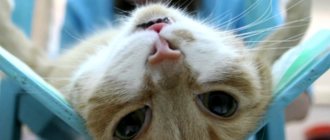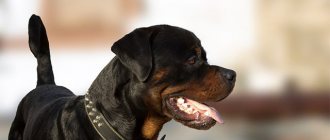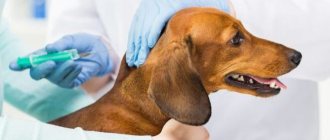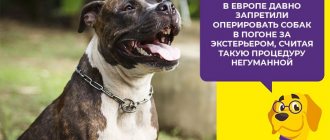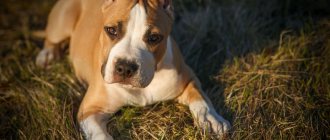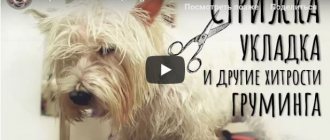Why do you need cupping?
Ear cropping is a surgical procedure in which part of the ear is removed. It is carried out for therapeutic and cosmetic reasons. Manipulation is needed for several purposes:
- Disease prevention. Removal is appropriate in case of organ trauma or necrosis. Undocked Staffies may suffer from ulcerations and neoplasms. The procedure will prevent or relieve the dog from such pathologies.
- Warnings for ear rupture during combat. It is recommended that they be docked for all hunting and fighting dogs.
Some take this step for personal reasons, believing that resection will make the dog look better. For show Staffords, cropped ears are standard.
How to prepare a dog
Before you take your puppy to surgery, prepare him. Initially, make sure that the Staffordshire Terrier:
- Not infected and 7-10 days have passed since possible illness.
- Has not been vaccinated in the last two weeks.
- I was treated for parasites half a month before surgery.
Since the dog is given anesthesia before the procedure, the dog should not be given anything to eat 12 hours before the procedure. Otherwise the staff will vomit.
Main contraindications to the circumcision procedure
Before performing docking on a dog, you must visit a veterinarian, who will give permission for this operation or, conversely, refuse due to the presence of contraindications.
Contraindications:
- Old age of the dog.
- Weakened immunity.
An animal that has a weak immune system is susceptible to risks and various complications.
- Pathologies and concomitant diseases.
If the dog is currently ill, surgery should be postponed until the animal recovers.
- Thin build and developmental delay.
Optimal age for cupping
The operation is best performed on young individuals. Why do small puppies have their tails docked? The most optimal age for this procedure: newborn puppies and those 2-3 weeks old.
They tolerate surgery best, as they have a strong immune system and a healthy body that can fight the consequences and complications. Wounds on the body of puppies heal faster, and blood circulation works well, which contributes to a speedy recovery.
An owner who is afraid of hurting his pet can ask the veterinarian to give him a painkiller injection or local anesthesia. The younger the dog is, the easier it will be able to undergo this operation.
Description of the procedure
Ear cropping of a Staffordshire Terrier is performed exclusively under general anesthesia. The duration of the manipulation is one and a half to two hours. Before cropping the ears of Staffy puppies, you need to pay attention not only to the age of the dog, but also to the gender. Breed also plays an important role. The ear should be the same length as the space between the leading edge of the ear and the inside corner of the eye.
The procedure goes like this:
- The dog is restrained. Place on the stomach, the forelimbs are brought forward, the hind limbs are brought back. The head is also immobilized.
- They give anesthesia.
- Wait for the anesthesia to take effect.
- Hair is shaved from the area of the ears and head.
- The operated area is treated with an antiseptic.
- Removal is carried out. To obtain a symmetrical shape, use a special pattern.
- After circumcision, the wound is treated with an antiseptic and stitches are applied.
- Bandages are applied to stop bleeding.
There are several types of surgical interventions and techniques that veterinarians use. Before deciding to have a resection, you should choose a clinic, a doctor and decide on the desired size and shape of the ears. Those who do not want to go to a veterinary clinic can call a veterinarian at home. This is possible, but the risk of infection in this case increases.
Keep in mind! During the effect of anesthesia, dogs do not close their eyes.
How is ear cropping performed?
The ear cropping technique is different for each breed:
- Dog. For this breed, it is customary to dock at the age of 3 months. The length to which the ear will be truncated is individual for each dog. If the ear cartilage is dense, it is recommended to make the docking longer. And if the ear cartilage is soft, cropping or low-set ears (on the skull) is not performed at all.
- Doberman. Age for docking is 2 months. In Dobermans, the auricle is truncated by 2/5 of the part. After docking, a metal structure called a crown frame is used to set the ears and give them the desired shape.
- Alabai. Cupping is carried out 3 days immediately after the birth of the puppy. There are 3 types of docking for Alabai: “bear” (rounded ears), “Caucasian” (1/3 is truncated) and standard (average length). Under zero ear cropping is unacceptable, as this will lower the dog’s immunity.
- Sheepdog. The procedure is carried out until the age of 7 days. If you do not meet this deadline, you will have to wait up to 6 months. The auricle is truncated almost completely.
- Staffordshire Terrier. The surgical operation is carried out from 1.5 to 4 months to form a normal auricle. Cupping is performed on 2/3 of the auricle.
- Pit bull terriers. Cupping is done at the age of 2-3 weeks. It can also be done from 2-3 months, but always before the formation of teeth, since during this period the puppy’s immunity is reduced. There are 3 options for the form of docking: exhibition (1/3 is truncated), short (1/2 is truncated), fighting (almost the entire length is truncated).
There are general rules for docking. When the dog is on the table where the operation will be performed, its limbs are fixed, a muzzle is put on, the vessels are pressed with a clamp, markings are applied to the ear, and the auricle is disinfected. To avoid deformation of the auricle, the sutures after ear cropping should be placed on the skin without touching the cartilage.
Docking is usually carried out on dogs at a very young age. The disadvantage is that the pet's muzzle is not yet formed and it is very difficult to determine the most suitable ear shape.
At any age, you can ask your veterinarian for at least local anesthesia, which does not carry any side effects.
Cropping a dog's ears is carried out in several stages:
- Anesthesia.
- Cleaning, hair removal.
- Disinfection.
- Correct skin position.
- Marking.
- Ear truncation (done with a scalpel).
- The seam.
- Edge processing.
Cupping is a simple surgical operation that is performed quite often. But after ear cropping, a dog may encounter complications:
- If cupping took place at an inappropriate age for the procedure, bleeding may occur. For pets with fleshy ears, bleeding is a predictable consequence. Therefore, their ears are cauterized before the procedure.
- Inflammation. This problem may arise due to poor sterility or suture dehiscence. Inflammation of the sutures may occur due to the pet’s low immunity.
- Scars, thickening. They may arise due to the age of the dog at the time of the operation or insufficient qualifications of the specialist who performs ear cropping.
Rehabilitation period
It is advisable for the owner to be present at the moment when the dog recovers from anesthesia. This will make it easier for the staff. It happens that dogs do not come to their senses for a long time. If there is measured breathing, it is not advisable to wake the dog. You just need to put the animal in a warm place or cover it with a blanket (it is allowed to use heating pads), because the staff will freeze while recovering from anesthesia.
Expert opinion
Anna Abramenko
An avid dog lover. Experience in veterinary medicine since 2009.
Ask a Question
Some dogs do not experience any difficulties or malaise after anesthesia; they quickly come to their senses and go to enjoy the well-deserved food. For others, this is more difficult: they may be lethargic for 12–24 hours and refuse food. The owner’s task is to help the pet survive a difficult period. It would be useful to turn the dog from side to side, stroke it, and talk.
Don't be alarmed if the animal is unsteady or hesitant at first - this is normal. It is imperative to make the Staffordshire Terrier drink and eat. There are several tricks that will stimulate your dog's appetite:
- Drop water onto the mouth area and into the mouth.
- Apply honey to the dog's lips and below the nose.
- Offer your favorite food.
Attention! If bleeding occurs, it is recommended to apply a gauze bandage soaked in a solution of hydrogen peroxide to the area.
Postoperative care
In order for the Staffordshire Terrier to recover quickly and the operation to give the desired result, it is worth following a number of recommendations.
Ear collar
Since the wound itches as it heals, it is important to prevent scratching. For such purposes, a special collar is used that is put on the dog. It is advised to wear it until the wound heals. After this, the itching goes away and the device can be removed. The collar is made of durable multilayer polyethylene, cardboard or plastic. They are easy to find in a veterinary pharmacy or pet store. The shape of the product can be round or curved.
Daily cleaning of seams with a tampon
To prevent the wound from festering, daily treatment with an antiseptic is required to prevent infection. This could be chlorhexidine or hydrogen peroxide. The crusts that appear are soaked and removed. Also, be careful not to get dust on your ears.
Walking a puppy in dry weather
Don't forget about walking your pet. The dog needs fresh air for a speedy recovery. After going outside, be sure to treat your staff's ears with an antiseptic solution. To calm and obedience the dog at these moments, praise him and give him treats.
Remember! Walking is allowed only in dry weather. Humidity will cause the wound to take a long time to heal.
Expert opinion
Anna Abramenko
An avid dog lover. Experience in veterinary medicine since 2009.
Ask a Question
If the threads are self-absorbing, then the stitches will not need to be removed, but if not, then you need to visit the veterinary clinic 10 days after the operation. For a speedy recovery, it is advisable to give your dog a complex of vitamins.
Operation: two methods of cupping
For many owners, it is still questionable why a dog needs to have its tail docked. The operation is carried out in two ways.
First way. Used for dogs with short muzzles. For relief, general anesthesia is used. During the procedure, the doctor makes sure that the tongue does not fall into the throat and does not interfere with the animal’s normal breathing. The doctor makes an incision between the vertebral discs and amputates part of the tail and ears, after which he places sutures of certain sizes on the skin and treats the area with an antiseptic solution.
Second way. A newborn puppy's tail is tied with a rope and left in this position for a week. There is a disturbance in blood circulation in the stretched area, gradually the nerve endings die off, and the tail falls off on its own.
The wound heals after some time. The puppy may experience pain. The veterinarian prescribes painkillers during this postoperative period, and the owner himself must treat the damaged area with an antiseptic solution every day.
Possible complications
In rare cases, complications may occur after surgery. The following factors influence:
- the doctor does not have sufficient qualifications and does not adhere to sanitary and hygienic standards during the manipulation process;
- the dog owner does not follow all the veterinarian’s recommendations in the postoperative period;
- the dog has poor immunity;
- improper preparation was made or the pet was sick;
- During the operation and during the recovery stage, drugs were used to which the dog was allergic.
Due to unqualified actions of the doctor or poor care of the owner, the following may occur:
- inflammatory processes, suppuration of sutures;
- hyperemia;
- bleeding;
- rashes;
- scarring and thickening of the edges of the ear.
Attention! In especially severe cases, complications arise all at once.
Inflammation, suppuration
Often, inflammatory processes with the appearance of purulent sacs in the area of the sutures appear if during surgery the doctor used a non-sterile instrument and did not properly treat the resection area. Also caused by suture dehiscence, low immune defense and infectious diseases. Regular antiseptic treatments and the use of antibiotics can stop inflammation.
Hyperemia (redness) and rash
Such phenomena indicate an allergic reaction, which can only be removed with antihistamines.
Bleeding
Significant bleeding occurs in dogs that have surgery at a later age. This is also possible when the animal overheats.
Scarring and thickening of the edges of the ear
Scarring of the Staffordshire Terrier's ears depends on the individual characteristics of the dog. Age plays an important role.
Remember! If the ears of a Staffordshire Terrier are cropped by qualified doctors and in accordance with all sanitary and hygienic standards, then there will be no complications.
Why do you need to crop your ears and tail?
Docking of Central Asian Shepherds has been accepted since ancient times. The reasons why our ancestors performed this operation:
- Alabai is a herding breed. Dogs often defended the herd from attacks by wolves and other predators and were often injured as a result of the fight. To reduce the affected area, Central Asian Shepherds began to have their ears and tail shortened.
- Asians with short ears and tails look much more menacing.
- Sometimes townspeople marked aggressive dogs in this way.
Nowadays, docking is practiced for service and fighting dogs, as well as for medical reasons.
In other cases, it serves only for aesthetic purposes and has no practical significance.
Pros and cons
Russian breed standards allow dogs with shortened ears and tails, as well as Alabais without docking, to be admitted to exhibitions.
In some European countries, this operation is prohibited and is considered animal cruelty. In Russia and the CIS countries, docking of the Central Asian Shepherd is still practiced.
Let us list the main arguments of breeders who advocate docking of the Central Asian Shepherd:
- An Alabai with uncropped ears and tail looks like a mestizo, while docking helps emphasize the dog’s breed characteristics.
- The dog will be freed from problems with some parts of its body. For example, a broken tail is very painful and takes a long time to heal.
- For service breeds, this procedure is necessary, as it protects the dog from additional injuries.
Now it’s worth talking about the negative aspects of cupping:
- Any surgical intervention carries certain risks for the dog's health.
- In most cases, there is no practical need for surgery.
- As a result of research, it was revealed that docked Alabai are more aggressive.
- Although the procedure is not very complicated, it will still cause the animal some inconvenience and pain.
Is it possible to leave it undocked?
Whether it is worth docking a Central Asian Shepherd depends only on the wishes of the owner. Nowadays, most Alabais live in private houses, which means that fights with wild animals are not expected. Therefore, there is no need for this procedure.
In addition, it is extremely undesirable to dock a puppy that is more than 14 days old. A dog goes to a new home when it is 2 or more months old.
At this age, shortening the ears and tail should be avoided, as the operation will not have the best effect on the pet’s health.
At what age is it better to dock?
The optimal age for the operation is considered to be 5–10 days from birth. At this time, the nerve endings in the baby’s ears have not yet fully formed, so the procedure will be practically painless. The bones on the tail have not yet become stronger, and their structure is more like cartilaginous tissue.
If the puppy is two weeks old, the operation will become much more difficult, and the baby will need stitches. It is already completely dangerous to dock a dog that is more than a month old.
